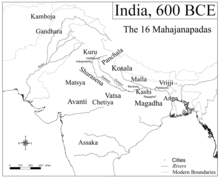

kamboja edit
kamboja close located to Gandhara, Kamboja is usually mentioned together with Gandhara. The Mahabharata connects kambojas with a place called Rajapura which was mentioned by Hieun Tsang which lay to the south-east of punch. The western boundries of Kamboja reached kafiristan. Elphinston found in that region tribes like the 'Camojee', 'Camoze' and 'Camoje' whose names remind us of the kambojas. A part from Rajapura, there are evidence of another city called Namdinagara situated in the Kamboja territory.[1]
Mahabharata edit
In Mahabharata, the Kambojas are represented as living under a monarchial system and mentions Chsndravarman and Sudakshina as kings. In later times the monarchy gave place to a samgha from of government. The Arthashastra calls them vara-shastropajivin samgha i.e., a confederation of agriculture, herdsmen, traders and warriors. Corporations of Kambojas(Kamjobagana) also find mention in the Mahabharata.
Monarchies and Republics edit
At the time of the Buddha there are two kind of state systems : Monarchial and republican. We have four most power full monarchies in the from of Vasta, Avanti, kosala and Magadha, whereas the rest were Gandhara types. Some of them joined together to become confederacies and other remained autonomous. Changes over from one system to another was not uncommon. The single republican tribes were the shakas, Kalingas, Mallas, Bhaggas, Moriyas, Bulis, Kalams, etc. The Vrijjis and Yadus were confederacy of tribes. The independed republican tribes emerging from the vedic tribes retained the tribal tradition on a larger scale than the monarchies where the tribal loyalty weakened giving way to caste and territorial identities. The popular vedic assemblies were retained in the gana-rajyas whereas they gave way to the rise of bureaucracy as well as the growth in the power of the brahmanas. Some of the tribal republics changed over to monarchies whereas kamboja changed from monarchy to a republic.
During the later Vedic period we have evidence of many types of kingdom such as bhaujya(paramount rule), svarajya (self-rule). vairajya (anointed for sovereignty), samrajya (empire), rajya (kingdom) etc. Accordingly, there were various kinds of kings: samrat, virat, svarat, ekrata and sura-raja. Kingship in the monarchy was basically hereditary nature of kingship was well established, which was reinforced by elaborate sacrifices such as rajasuya, ashvamedha, vajapeya etc.
See also edit
Notes edit
References edit
- ^ Agnihotri & Indian Histor, pp. 174.
Sources edit
- Agnihotri, V K. (2010). Indian History. Allied Publishers Ltd.-new Delhi. p. 174. ISBN 9788184245684.